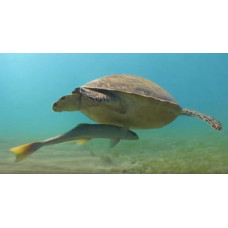Latin name
Remora remora
Other name
Remora remora
Identification
The body of the common remora is flattened horizontally in front and vertically behind. Lower jaw strongly protruding forward, mouth rather large, teeth small and thin. Eyes small. The sucker has 17-19 plates. The lateral line runs in a high arc over the pectoral fin.
Features of fish fins
Caudal fin with a small notch. Pectoral fins are rounded. During development, the fin becomes a pectoral disk. Dorsal spines (total): 0; Dorsal soft rays (total): 22-26; Anal spines: 0; Anal soft rays: 22-24.
Fish colouring
This species has a dark brownish-gray body coloration.
Distribution
Widespread in warm tropical and subtropical waters of the world ocean. Occurs roughly between 60°N and 36°S. In the eastern Atlantic (the most common member of the family), north to Scotland; Mediterranean Sea. Occasionally swims into Primorsky Krai waters in summer.
Habitat
Subtropical marine pelagic species. Depth range from 0 to 200 meters.
Size
The maximum recorded size is 86 cm and the mass is 1.1 kg. However, they are usually found much smaller: 30-40 cm.
Behavior
This fish uses its sucker to attach itself to large marine animals such as sharks, bony fish and turtles, and makes long migrations, often over great distances.
Food and feeding habits
They feed on small crustacean parasites from the skin of their hosts, as well as planktonic animals. They prey on small fish and pelagic invertebrates.
Reproduction
Spawning occurs in the Central Atlantic in early summer and in the Mediterranean in late summer and fall. Eggs and juveniles are pelagic. Juveniles swim freely. At 3-8 cm in length, they attach themselves to host animals.
Fishing
This species is not commercially important.
Relationship with a person
The flesh of these fish is edible.
Interesting facts
Residents of places where Common Remora are found use them to hunt large fish and turtles. The hunters tie the fish to their tails with a thin, strong line and, after approaching a group of turtles by boat, lower a live hook into the water. Common remora are quickly sucked into the turtle. All the hunter has to do is pull up the prey.
| Classification | |
| Phylum | Chordata |
| Class | Actinopterygii |
| Squad | Carangiformes |
| Family | Echeneidae |
| Genus | Remora |
| Species | R. remora |
| Features | |
| Conservation status | Least Concern |
| Habitat | No information |
| Life span, years | No information |
| Maximum body weight, kg | 1,1 |
| Maximum length, cm | 86 |
| Sailing speed, m/s | No information |
| Threat to people | Edible |
| Way of eating | Predator |
Common remora
Tags: сommon remora



